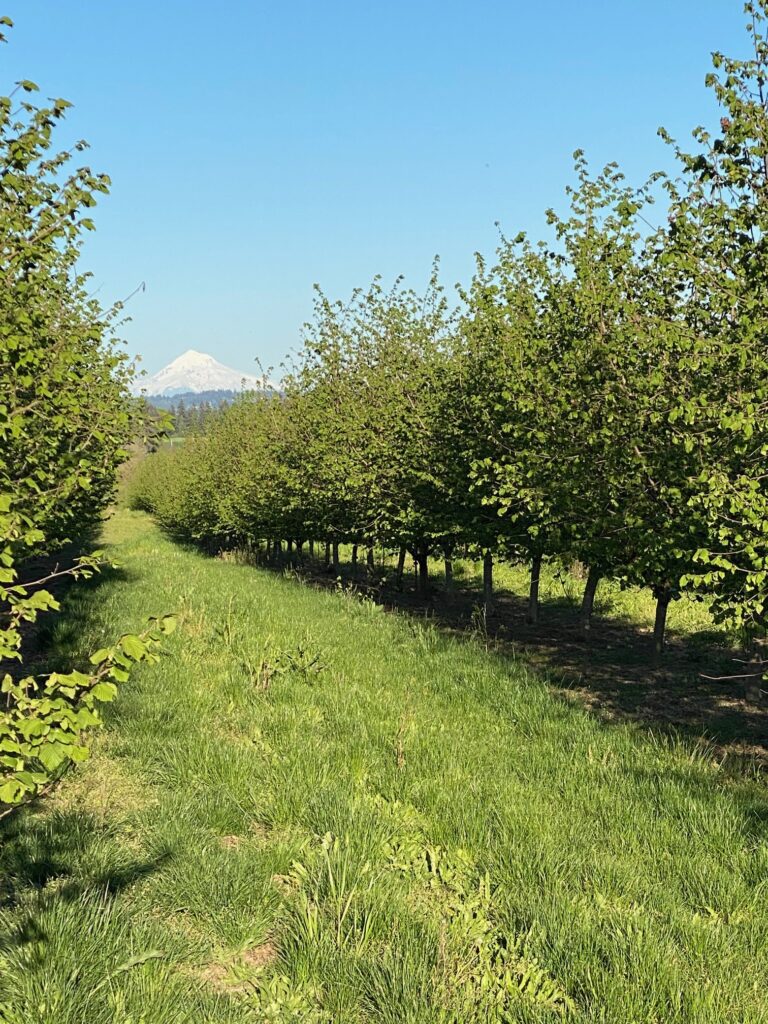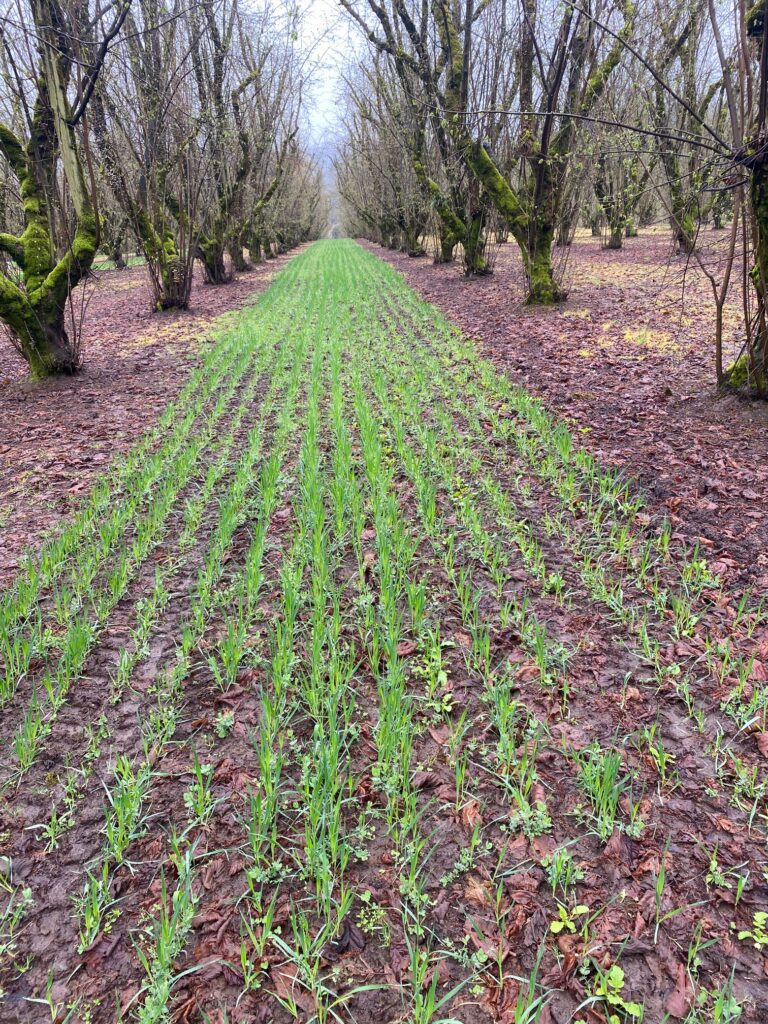An interview with Willamette Valley hazelnut grower Dan Brown
Acres U.S.A. It’s the end of March; where are you in terms of your season?
Brown. Stuff’s just getting started. Trees are at bud break now and a little past, depending on variety. We’re starting to work on grass control, tree fertilization, etc.
Acres U.S.A. How many acres is your operation, and how many acres are hazelnuts?
Brown. We’re doing about 350 acres of hazelnuts. We have a few walnuts, and then some grain and seed crops. We have some corn, wheat, some clover for seed, some oats.
Acres U.S.A. And you’re in the Willamette Valley, correct?

Brown. We are, yes.
Acres U.S.A. That’s the seed capitol; is it unusual to have an orchard there as well?
Brown. No — 99 percent of the hazelnuts grown in the U.S. are in the Willamette Valley. Just about any crop you can think of is grown here. There’s over 200 crops growing in the Willamette Valley. Grain corn is actually very rare here. The last few years with the high corn price, it’s been pretty good. But there’s quite a bit of silage corn grown for dairies. If you tell people here you grow corn, they think you’re growing silage or sweet corn.
Acres U.S.A. How old is your orchard?
Brown. We have orchards that are in their first year and some that were probably planted in the forties or fifties. The ones that are planted that long ago are definitely toward their end of their life. Actually, just outside my window, there’s a 40-year-old orchard and we’ve taken a block of a third of it out this year.
Acres U.S.A. How tall do these hazelnuts get, and how shaded is the ground?
Brown. This particular orchard is a Barcelona orchard, and they’re 30 to 35 feet tall and they can be full canopy. Yeah, you go through there in the middle of the afternoon and it’s shade.
Acres U.S.A. Here in the Midwest they’re more of a bush. Is it like that for you as well?
Brown. We train them to be more of a tree, even though they want to be a bush. It’s a management headache to try to keep them being a tree for management reasons. Harvest being probably the biggest one.
Acres U.S.A. You just prune every sucker that comes up and keep a single stem?
Brown. Pruning and spraying suckers is an endless task of a Willamette Valley hazelnut farmer. It’s four or five times a year. We don’t use glyphosate. We use 2,4-D, glufosinate, paraquat. I talked to a guy in California that sprays straight 32 for walnut suckers. I want to try experimenting with that this summer. Because the fertilizer is so hot, you’re essentially burning them with fertilizer versus the chemical.
Acres U.S.A. What do you do for cleaning up your rows in the winter?

Brown. If we get some dry weather in winter or early spring, we like to flail mow. We try to get most all the nuts, but we at least chew up on the leaves.
Acres U.S.A. What’s your journey with this? This was started by grandparents or great-grandparents, I assume, if you have trees that old.
Brown. Great-great, actually. I’m fifth generation. We haven’t always been a hazelnut farm. We started in hazelnuts, I believe, in the sixties. The reason we have some older trees is those are leased orchards that were established prior.
We’ve been a dairy farm before. They sold the cows in the early seventies.
Acres U.S.A. And more recently, what drove your movement toward a more regenerative direction?
Brown. Just noticing tree health declining significantly, so trying to figure out why. A very normal kind of observation among a lot of farms — not just hazelnut farms, but farms in general — is continuously having to put more inputs on to get a similar or lower yield, and trying to figure out why.
One key moment was an NRCS rain runoff infiltration demonstration I saw. That was very eye-opening. They took a surface cutout sample of different soil coverage — from bare soil to grass to native weed population. Then they apply a simulated rainfall at a reasonably high, but not crazy high, rate. Then they do infiltration and runoff testing into clear mason jars, so it’s very easy to see results.
With bare soil, the runoff is super dirty — lots of erosion, and infiltration is almost zero. On ground with some sort of growing ground cover there’ll be almost no runoff, and full saturated soil, and mostly clear infiltrated water.
Acres U.S.A. This is a test that they did on your farm, or at a different place?
Brown. This was done at a hazelnut growers meeting in the summer of 2018. They took actual samples from various hazelnut orchards in the Willamette Valley to try to be representative of different ground care methods. Seeing it was very eye-opening. It put proof to the theory that covered ground infiltrates more.
We had erosion problems before — some significant ones. We were trying to figure out ways to do better with that and to not lose our limited topsoil. Traditionally, hazelnuts were planted on hills, so rain is naturally going to be erosive. They were planted on hills because, traditionally, when older orchards were planted, it was hand harvest labor.
Acres U.S.A. What was your fertilization, herbicide, pesticide use in the past compared to now?
Brown. We would spray up to four fungicide passes, two insecticides, three or four herbicides. On the orchard floor, we use to have completely bare soil. People think it looks pretty; that’s still the standard practice. Leaving a grass center — or more of a weed center — is becoming a little more common, but the two insecticides is still very standard.

Acres U.S.A. In terms of passes, what are you down to?Brown. It’s not so much that we’ve reduced that many, it’s more just switching from chemistry to fertilizer. We’ve definitely pulled some back. Probably pulled back a third, I would say — a third of the passes. Our herbicide use is probably a third, and fungicides are way down. We still have a few orchards we’ll put a little bit on. That’s the Eastern Filbert blight, which came in the late eighties/early nineties and was an industry shift 30 years ago. That’s mutated and is now infecting all of the new varieties as well. The recommendation by the college is to spray the new varieties that are resistant to the blight — to spray them four times a season as a preventative measure in the springtime. We’re not taking that path at this time. That’s like taking preventative penicillin.
















